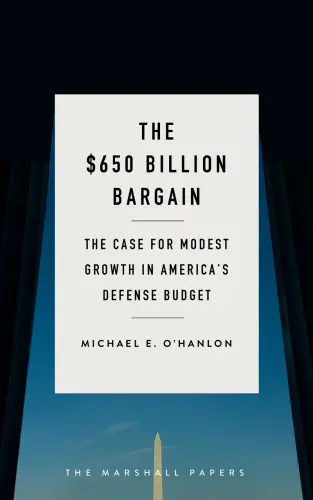The United States vastly outspends its rivals and allies on defense, but today experts debate whether that spending has delivered a military ready to confront the threats and challenges that the nation faces. On November 2, the Foreign Policy program at Brookings hosted an event to discuss the state of U.S. military readiness. Brookings Senior Fellow Michael O’Hanlon moderated a panel of experts, which included members of two branches of the military and two former civilian defense leaders.
Amid reports of aviation crashes, the periodic use of retired weapons, and worrying statistics about the availability of vessels in critical regions—and with defense spending recently increased to $716 billion—they discussed how the military is seeking to improve its readiness shortfalls while simultaneously investing in modern weapons and platforms.
The view from the Pentagon
O’Hanlon cautioned that anybody with an agenda can highlight specific instances of readiness shortfalls to make a case for greater military spending. Because accurate data on the armed forces’ readiness can at times be difficult to access, O’Hanlon argued that anyone who participates in this debate must take care to differentiate between agenda-driven arguments and data-driven ones.
O’Hanlon first turned to Brookings Nonresident Senior Fellow Mara Karlin, who explained that discussions about readiness must begin—but often don’t—with answers to the questions: “Ready for what?” and “Ready for when?” She stressed that within the Department of Defense, there are different interpretations about what readiness means and how to achieve it. She then assessed the effects of the 2011 Budget Control Act, which reduced defense spending and unleashed numerous readiness issues—equipment maintenance shortfalls, degradation of training, lower exercise numbers—in the context of America’s extensive post-9/11 overseas commitments.
She considered how military readiness would be affected by the most recent National Defense Strategy, which calls for the United States to compete with, and be ready for conflict with, China and Russia. To prepare for competition, Karlin noted that one would want U.S. forces to be out and about frequently, on display for the United States’ great power competitors; to prepare for conflict, one would want to avoid that and instead focus on increasing readiness for contingencies. The Pentagon must determine how to balance these two priorities, Karlin stressed.
Finally, asked by O’Hanlon to give her bottom-line assessment of where readiness stands today, Karlin said the force is in a good spot for competition, where she gave a rating of 7 out of 10. But with the possibility of actual conflict with a great power, she gave a rating of 3 out of 10.
Deloitte executive Alan Estevez—who last served in the Department of Defense as principal deputy under secretary for acquisition, technology, and logistics—offered an anecdote, describing internal Pentagon discussions with senior military and civilian leaders about the defense budget. He noted that if they could not explain what military readiness meant to a room full of people who essentially had PhDs in readiness, it would be even harder to do so to Congress and to the general public. Estevez noted that readiness, as such, is difficult to define in the abstract, and that in fact one only knows if the military is ready once it is tested. If one has the wrong force with the wrong mix of equipment or the wrong leadership, one can think the force is ready when in fact it is not.
Estevez stressed that while there is an enormous amount of data available on the state of the armed forces, most of it is not helpful information: Without the right analytic lens, data on its own cannot provide a complete understanding of complex systems. Finally, in response to O’Hanlon’s question about his bottom-line assessment of where readiness stands today, Estevez agreed with Karlin on a rating of 7 in the context of competition, but on conflict, he said that the United States does not have the modernization it needs going forward.
The view from the field
O’Hanlon then turned to U.S. Navy Commander Brendan Stickles, a federal executive fellow at Brookings, who noted that while there is presently a quest for a 355-ship navy, today there are only 286, of which only 30 percent are at sea—14 percent in training missions, and 16 percent conducting actual missions. Stickles then described his experience with the F/A-18 Super Hornet, which was delivered in 2000 under the assumption that it would save some $1 billion. But 9/11 occurred, followed by the U.S. invasion of Afghanistan, which became the longest war in U.S. history. The use of the F/A-18 for bombing missions in Afghanistan has put enormous strain both on the aircraft and on the Persian Gulf-based aircraft carriers from which their missions are launched—the equivalent distance of conducting close air support around Chicago from a launch point in Kitty Hawk, North Carolina.
Stickles drew attention to a recent alarming milestone: He flew a jet off the USS Eisenhower on New Year’s Eve 2016, but the following day—New Year’s Day 2017—there was no aircraft carrier out at sea anywhere in the world. It was the first time this has happened since World War II. Later that week, a B-2 stealth bomber launched from Missouri to drop bombs in Libya, which amounted to borrowing from strategic assets to perform a mission tailor-made for an aircraft carrier.
Stickles noted that there nevertheless are reasons for optimism in the readiness crisis, because a growing emphasis on improving supply chains and facilitating stronger data analytics has already yielded promising results in narrowing readiness gaps. He described how partnering with Delta has helped to incorporate industry best practices into the military’s maintenance practices. When O’Hanlon asked about the effects of continuing resolutions on readiness, Stickles explained that short-term funding impacted long- and medium-term planning. To keep his air crew ready, he said, he could not schedule training more than six weeks out, keeping his team behind and unable to get ahead of problems they encountered.
Finally, Marine Corps Colonel Amy Ebitz, also a federal executive fellow at Brookings, stressed that the United States Marine Corps prides itself on its readiness for emergencies. However, looking to the future—particularly in the context of great power competition and defense spending shortfalls—she worries about keeping that readiness intact. Ebitz said her biggest concern is that while U.S. forces have been uncontested in the air and sea in modern times, the United States cannot take that for granted in the future—and that to ensure the United States can prevail in future fights, the armed forces must evolve to face not only non-state extremists, but also near-peer nation-state actors.
Asked about the effects of sequestration and continuing resolutions on the readiness of the Marine Corps, Ebitz compared the situation to living paycheck-to-paycheck, where someone who is strapped for cash might ignore problems in his car and drive it until only absolutely forced to make very costly repairs. On the Marine Corps’ readiness today compared to previous periods, Ebitz explained that while the Marine Corps is ready to fight an enemy today, the future is less certain. She referenced former Defense Secretary Donald Rumsfeld’s maxim that “you go to war with the army you have,” and that regardless of the state of military readiness, the armed forces will always take the fight that it faces.
The Brookings Institution is committed to quality, independence, and impact.
We are supported by a diverse array of funders. In line with our values and policies, each Brookings publication represents the sole views of its author(s).






Commentary
Is the U.S. military ready for the threats it faces? Experts discuss
November 7, 2018